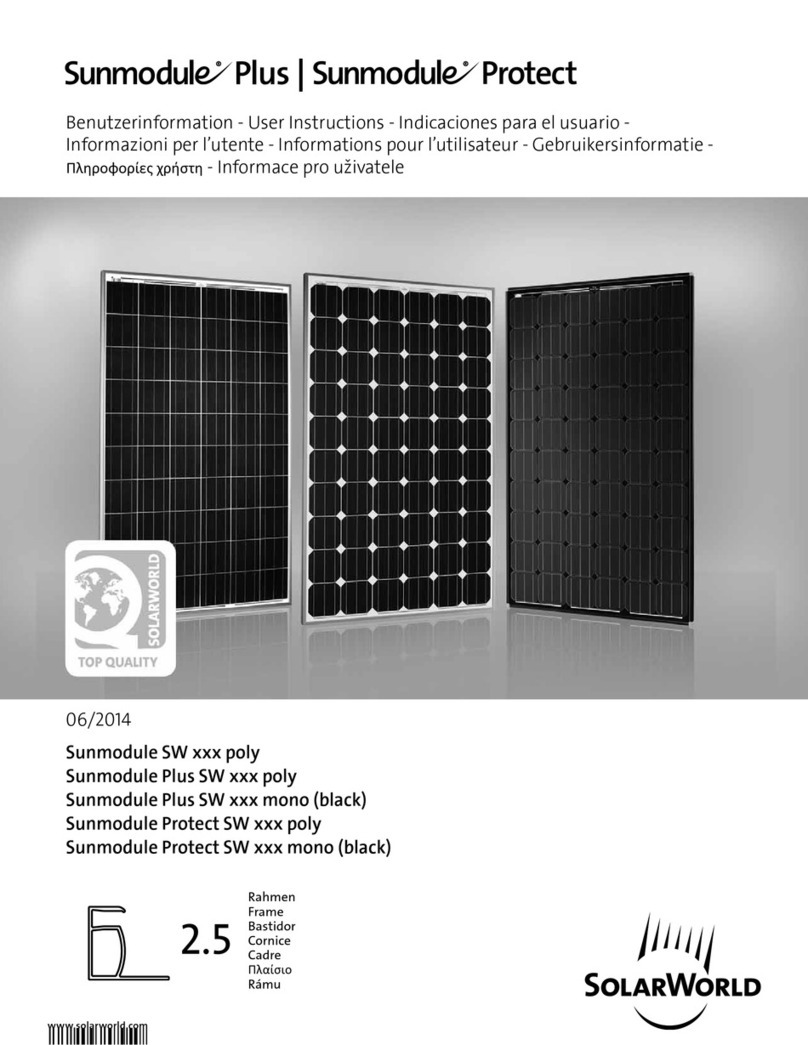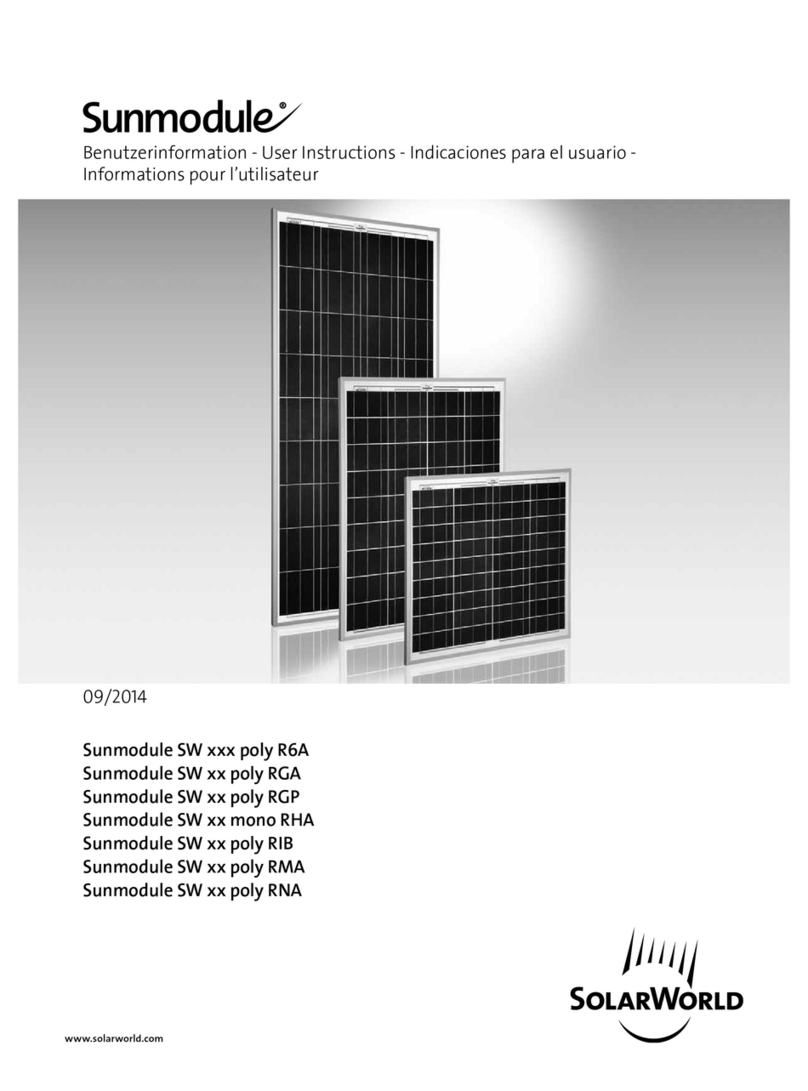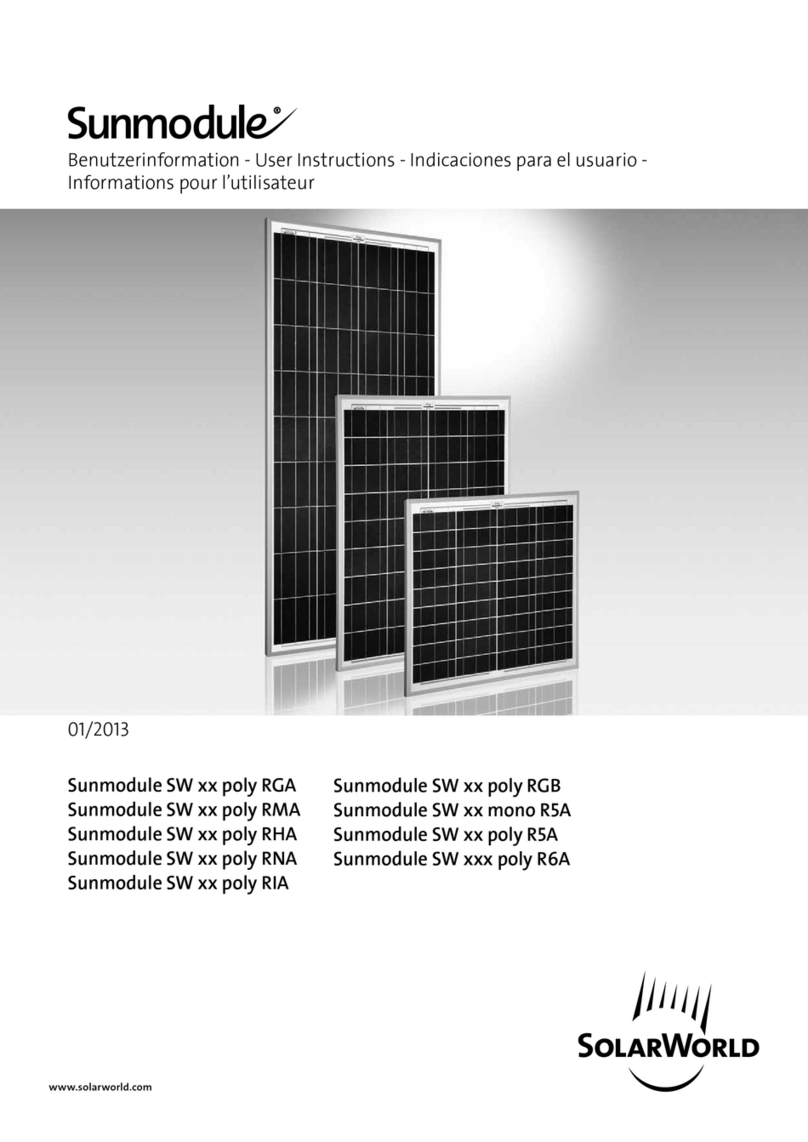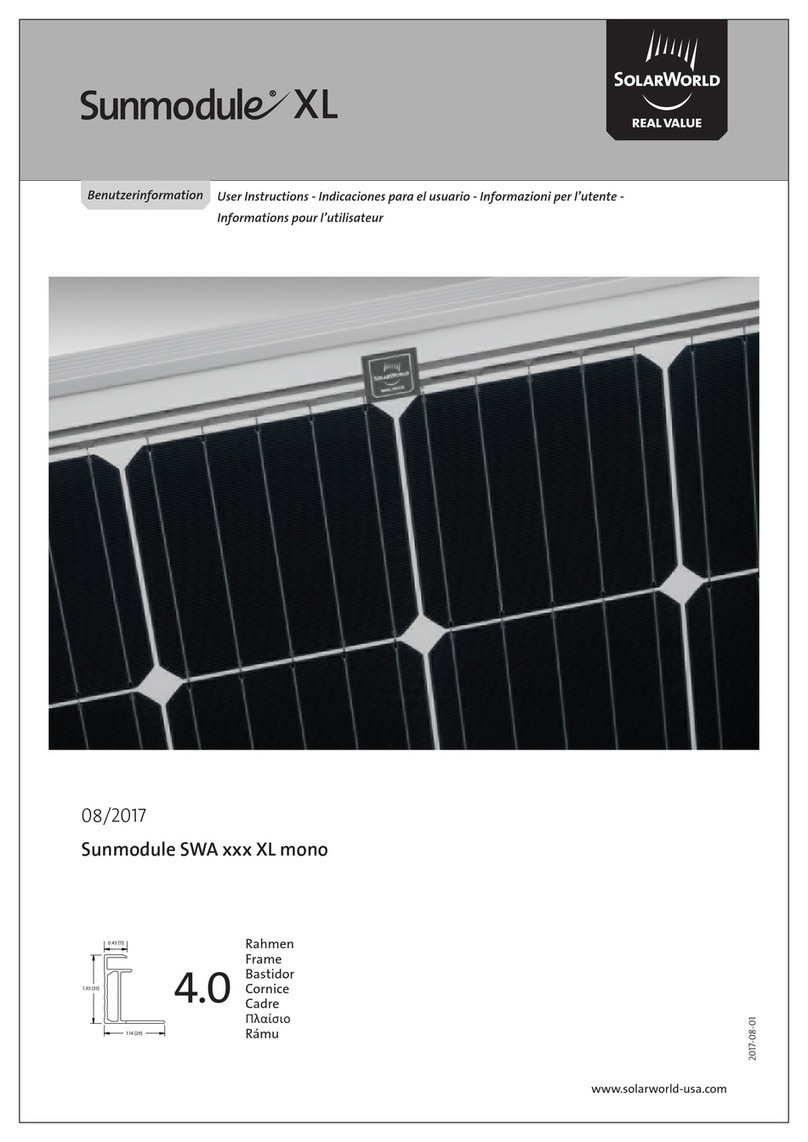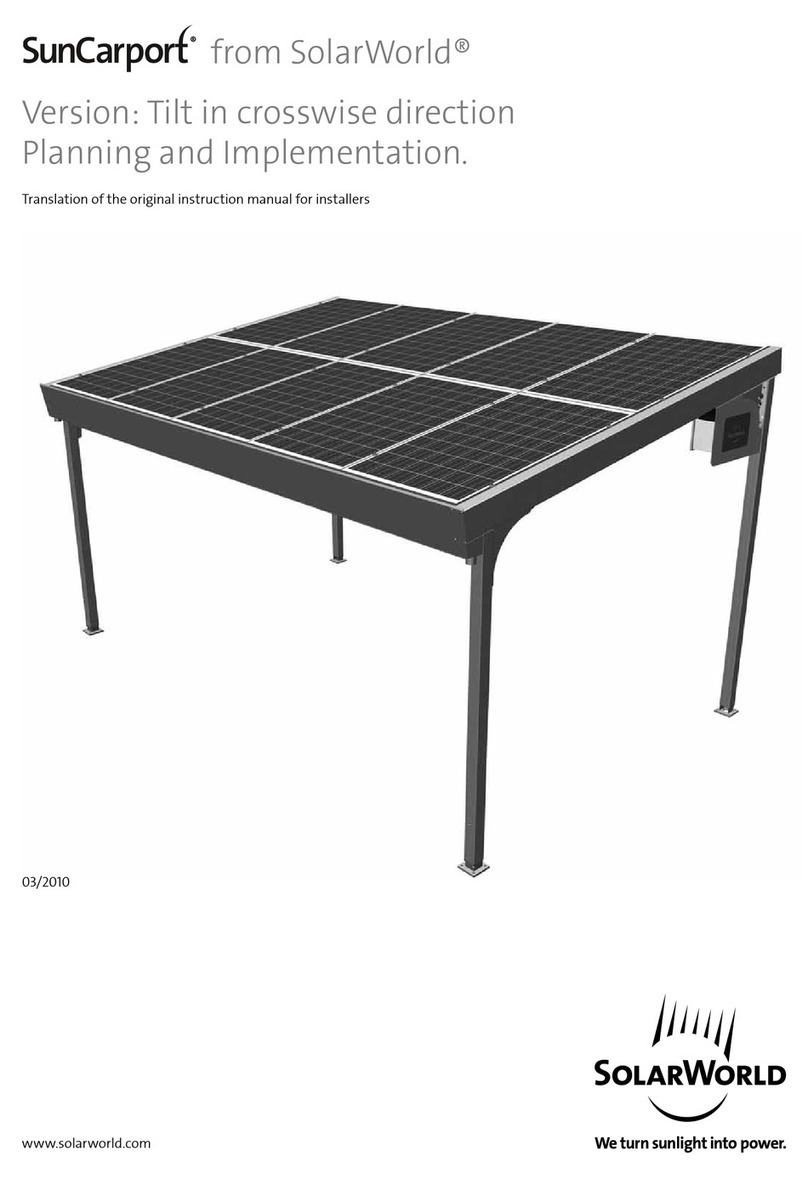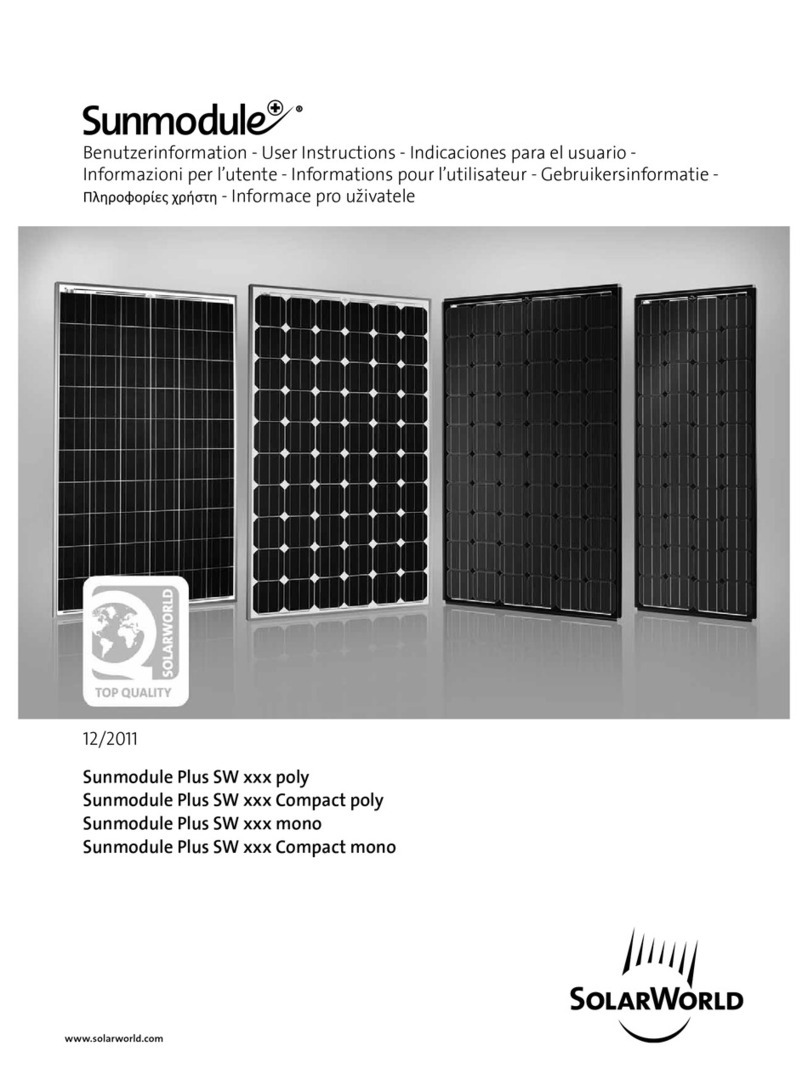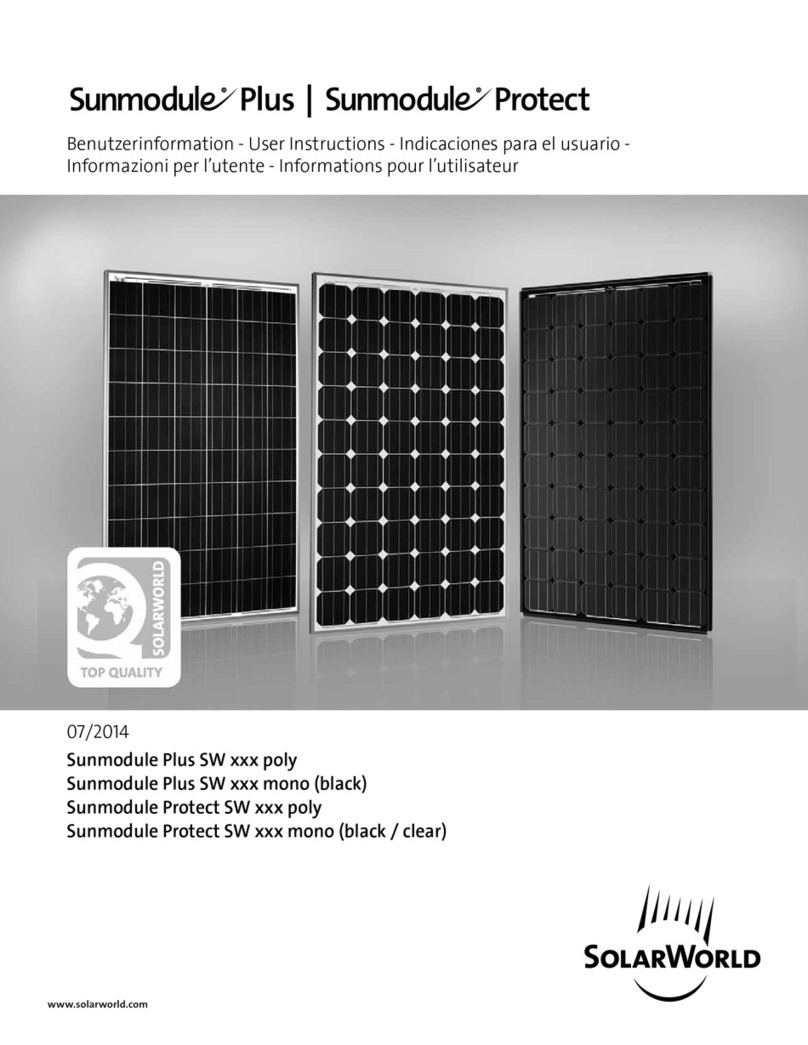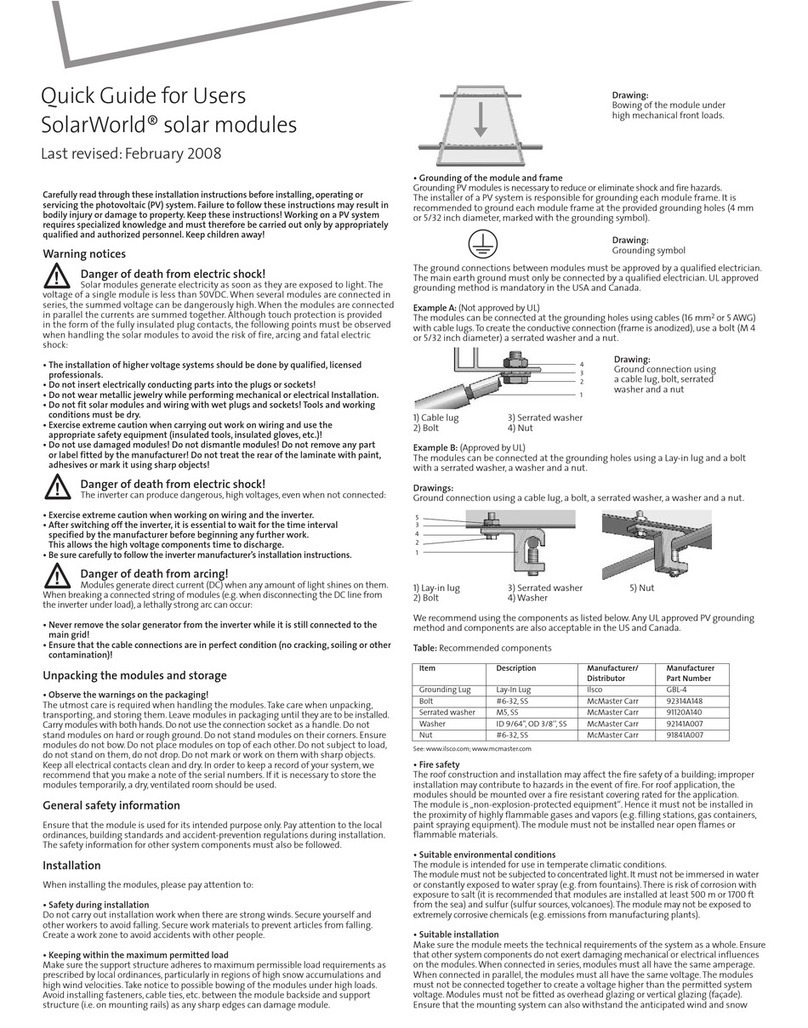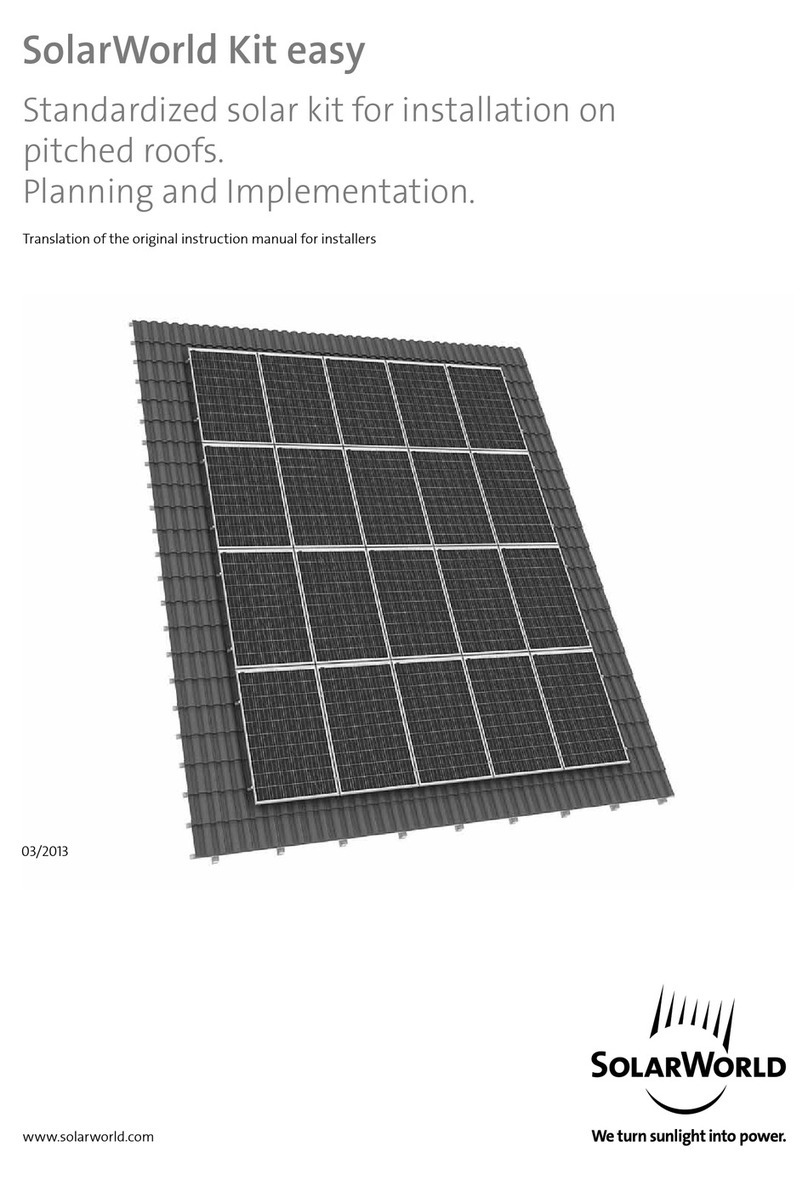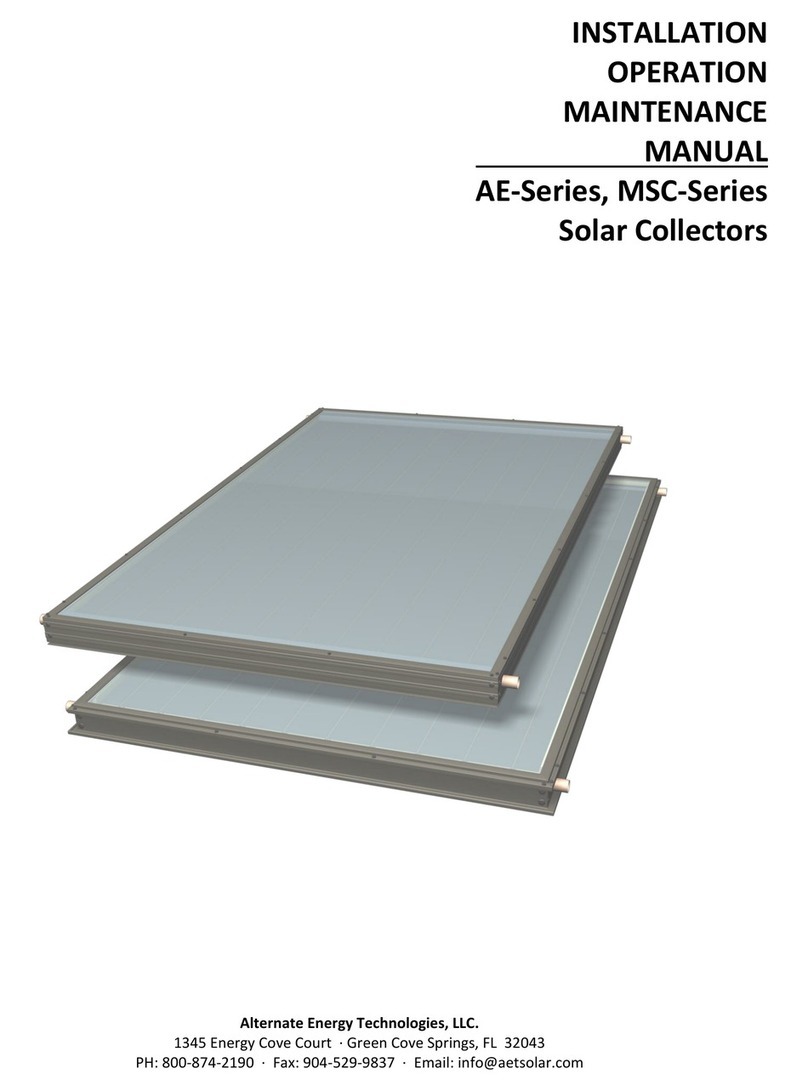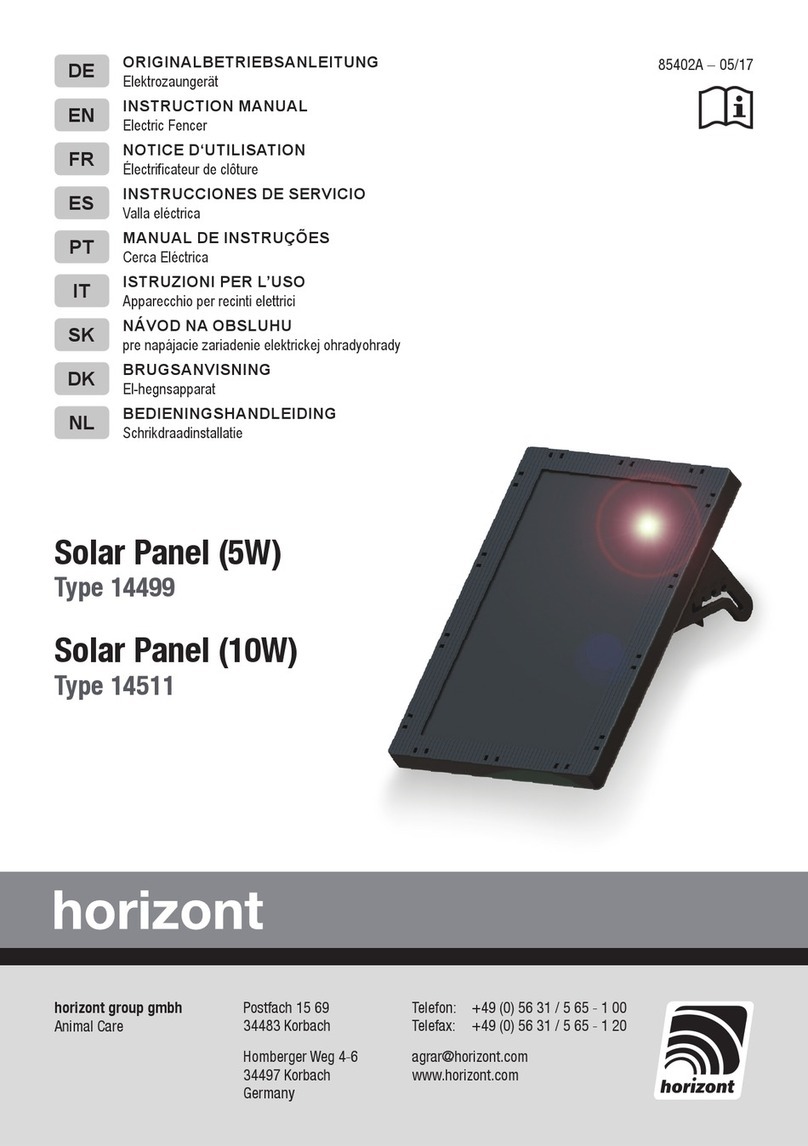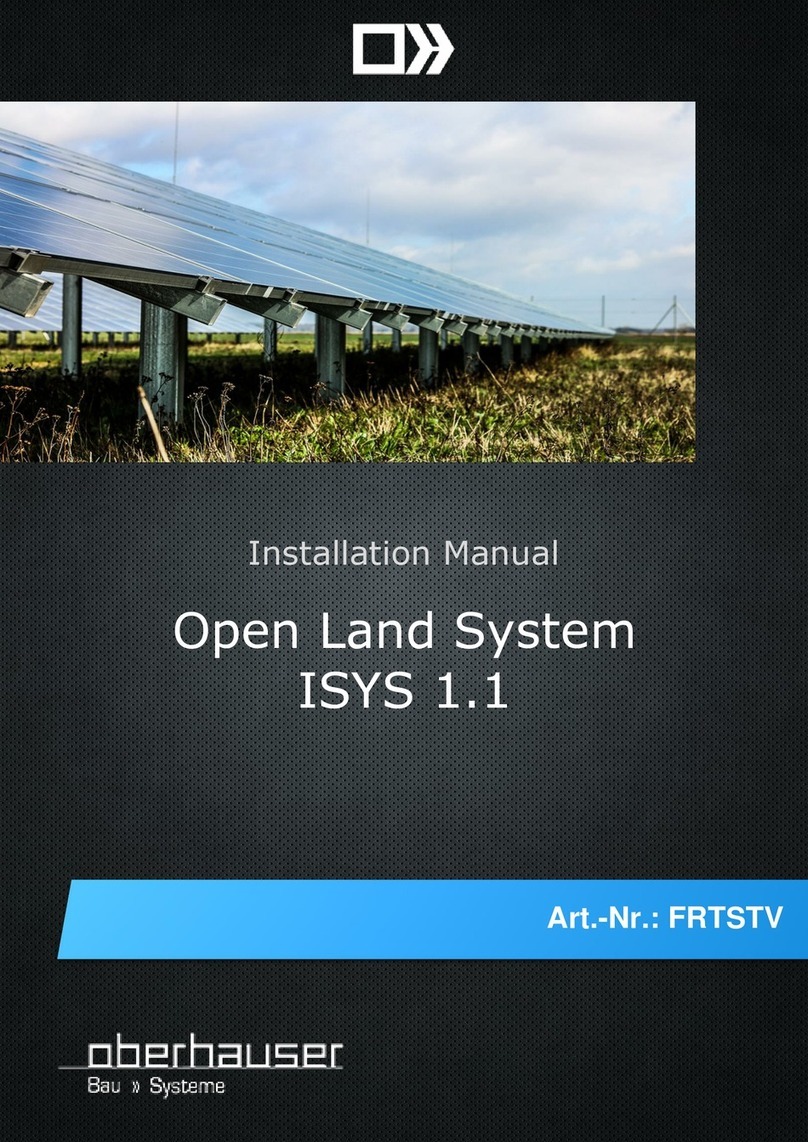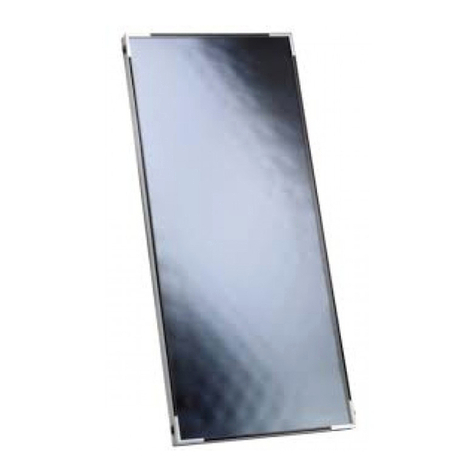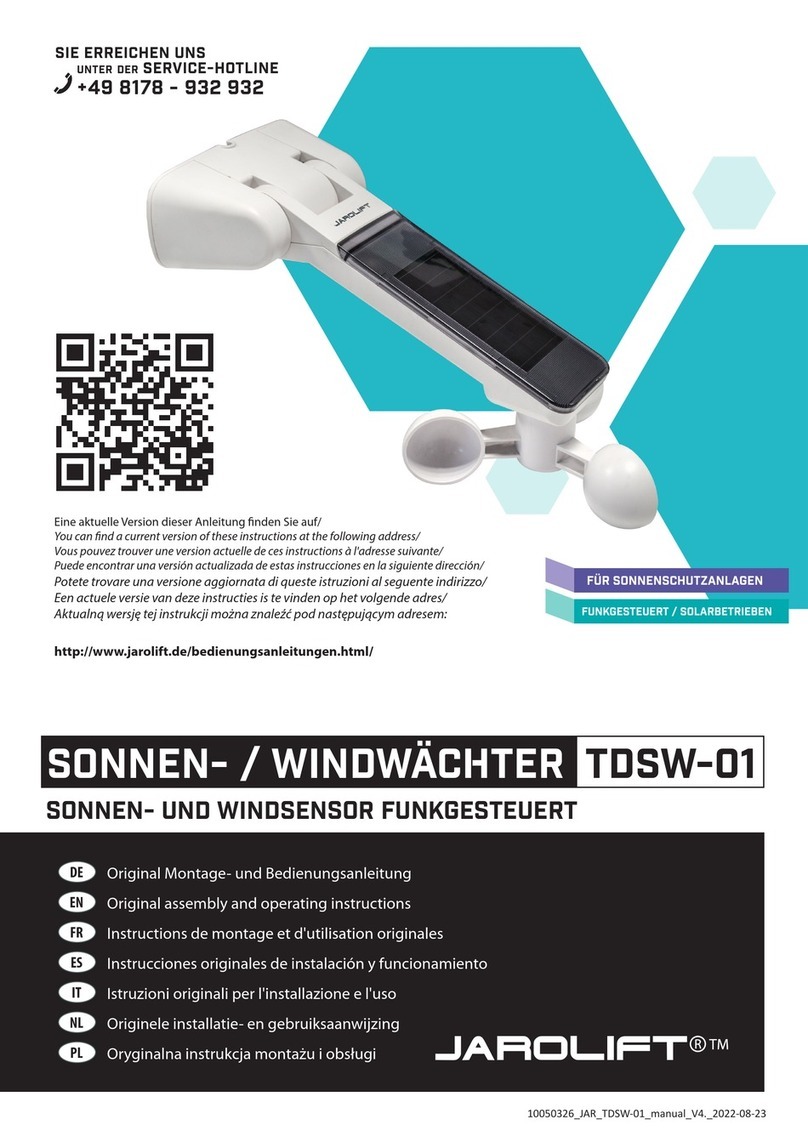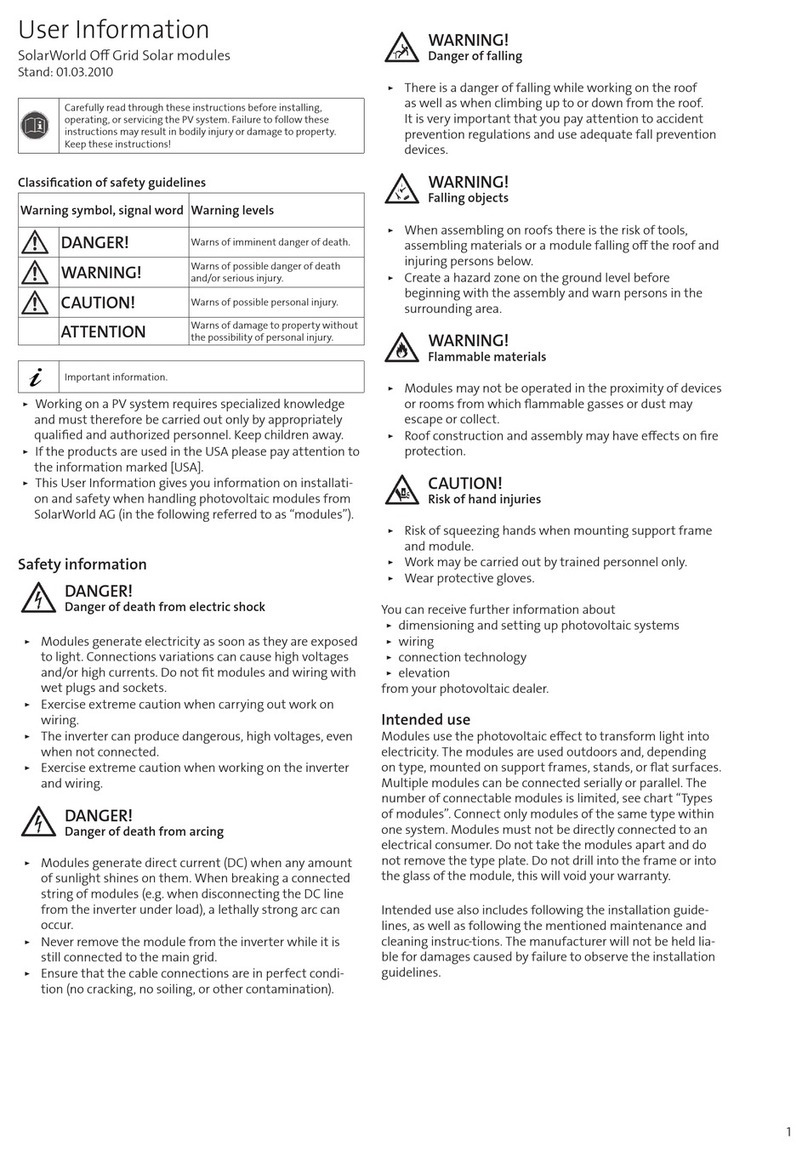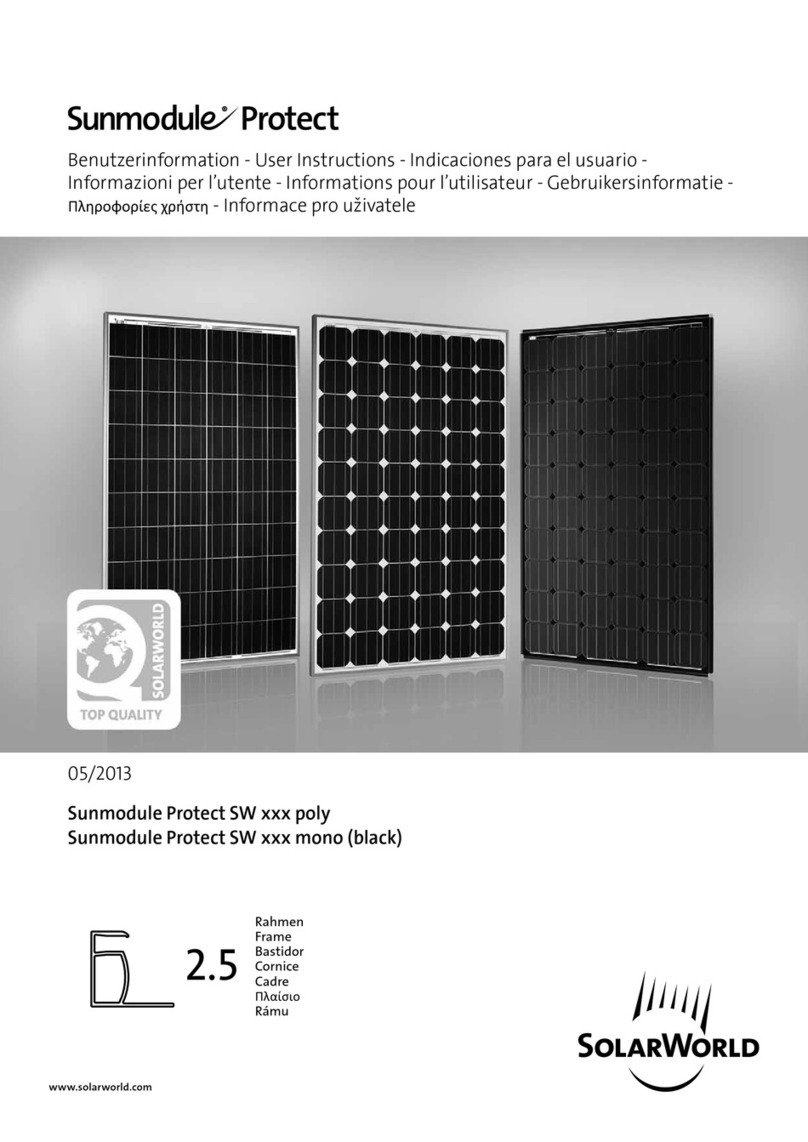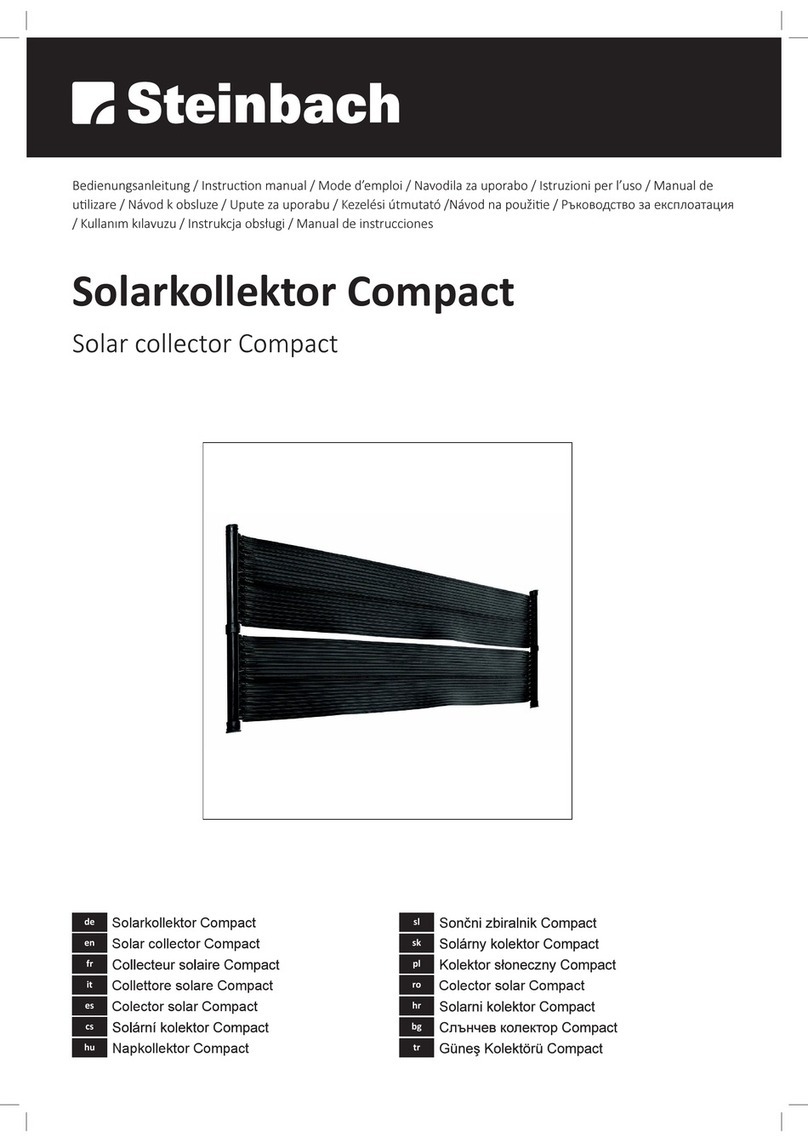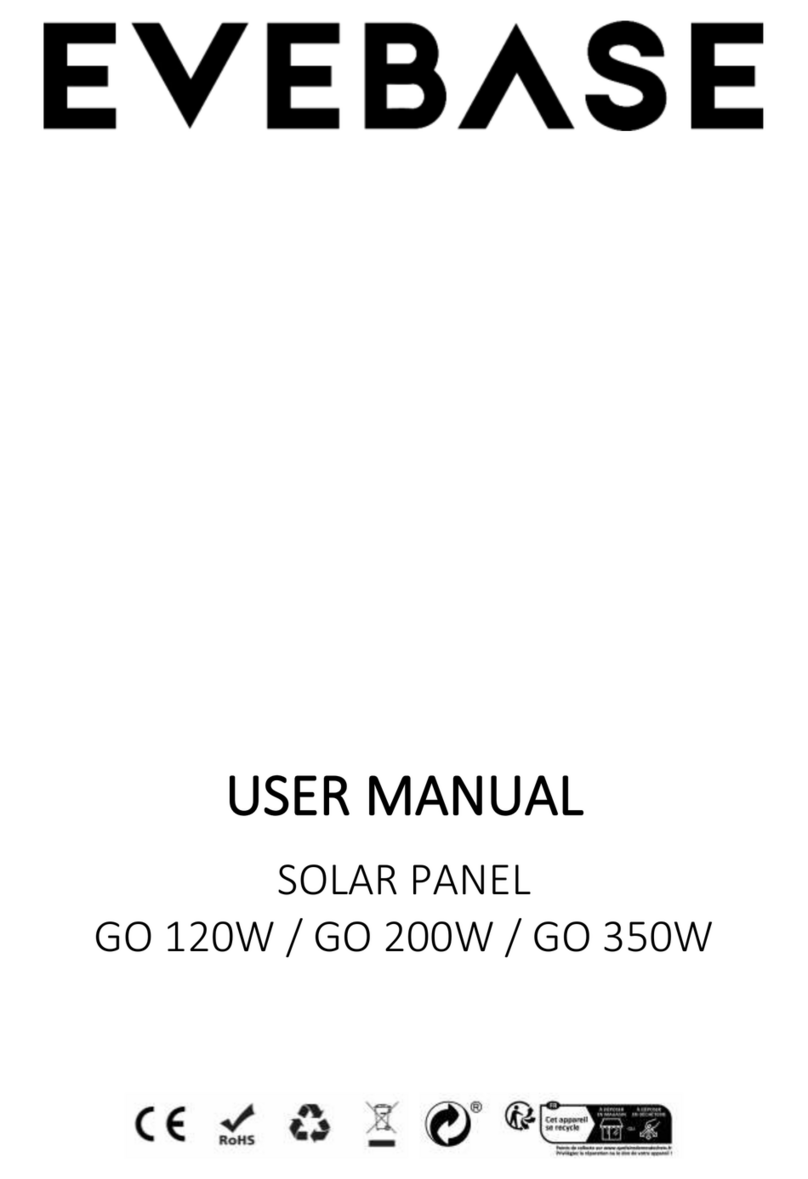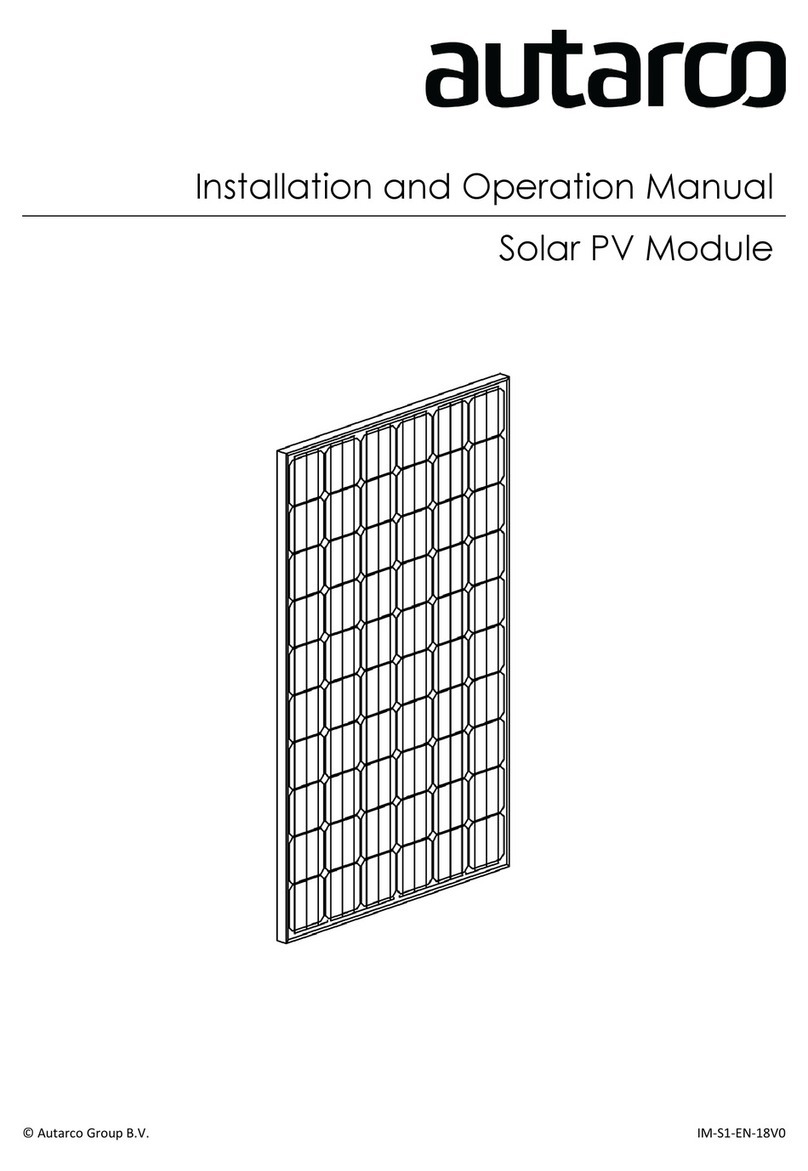DANGER!
Electric shock
The connection of several modules in series creates increased voltage and may
impose danger. Do not insert electrically conducting parts into connectors! Do
not install solar modules and wiring with wet connectors! Make sure to work
with dry tools and under dry working conditions!
Work on live parts
When working on wiring, use and wear protective equipment (insulated tools,
insulated gloves, etc.)!
ATTENTION
Do not use damaged modules. Do not dismantle modules. Do not remove any
parts or nameplates installed by the manufacturer. Do not apply paint or adhe-
sives on the back side. Do not work on modules with sharp objects.
WARNING!
Arcing
Modules generate direct current (DC) when exposed to light. When breaking a
closed circuit, a dangerous arc may be generated. Do not cut any live wires.
Safe installation
Do not carry out installation work in strong winds. Secure yourself and other
persons to prevent falls. Secure work materials against dropping. Ensure a safe
working environment so as to prevent accidents.
Fire prevention/explosion prevention
Modules must not be installed in the vicinity of highly flammable gases, vapors
or dusts (e.g. filling stations, gas tanks, paint spraying equipment). The safety
instructions for other system components must also be followed. Make sure to
comply with local standards, building regulations and accident prevention regu-
lations during installation. For roof installation, modules must be mounted on a
fire-resistant base material.
Unpacking and intermediate storage
Do not use the junction box as a handle. Do not place modules roughly on hard sur-
faces or on their corners. Do not place modules on top of each other. Do not step or
stand on modules. Do not place any objects on modules. Do not work on modules
with sharp objects. Store modules in a dry place. Leave modules in original packaging
until ready to install.
EN
Table: Recommended components for grounding in the US and Canada
Item Manufacturer/Description Tightening torque
Bolt (1) #10-32, SS 25 Ibf-in (2.9 Nm)
Serrated washer (2) M5, SS
Washer (3) ID 9/64’’, OD 3/8’’, SS
Nut (4) #10-32, SS
Lay-In lug (5) Ilsco GBL-4DBT (E34440) 35 in-lb, 4-6 AWG stranded
25 in-lb, 8 AWG stranded
20 in-lb, 10-14 AWG sol/str
Body Conductor Diameter Voltage Diode Max. Series Fuse
IEC 12-14 AWG (2.5 - 4 mm²) 5.5 - 7.8 mm 1000 VDC SL1011 15 A
UL 12 AWG (4 mm²) 7.1 ± 0.2 mm 600 VDC SL1011 15 A
General Information
This module is rated for use in application class A according to IEC 61730. For the elec-
trical ratings please refer to the datasheet. Under normal conditions, a photovoltaic
module is likely to experience conditions that produce more current and/or voltage
than reported at standard test conditions. Accordingly, the values of ISC and VOC
marked on this module should be multiplied by a factor of 1,25 when determining
component voltage ratings, conuctor current ratings, fuse sizes, and size of controls
connected to the PV output.“
Assembly
▹▹Recommended angle of inclination for photovoltaic operated stand-alone
systems/year-round use.
Latitude Fixed angle of inclination
0° - 15° 15°
15° - 25° equal to the latitude
25° - 30° Latitude + 5°
30° - 35° Latitude + 10°
35° - 40° Latitude + 15°
over 40° Latitude + 20°
Your local photovoltaic dealer can give you information about a suitable installa-
tion location and method.
Grounding of the module and frame
We recommend ensuring the functional grounding of the module metal frame. If
an exterior lightning protection system is already provided, the PV system has to be
integrated into the protection system against direct lightning stroke. Local standards
shall be observed.
Grounding in the US and Canada
Grounding hardware can be installed utilizing a lay-in lug, bolt with serrated washer,
washer and nut. The lug must be a tin-coated copper lug, silver in color. Do NOT use
a bare copper lug, which is brown. Any grounding method and components listed
according to NEC requirements are also acceptable in the US and Canada.
1
2
3
4
5
Cleaning
On principle, the modules do not need much cleaning if the tilt angle is sucient
(> 15°; self-cleaning by rain). If soiling occurs, we recommend cleaning the modules
with plenty of water (hose) without the addition of cleaning agents but applicati-
on of a soft cleaning device (sponge). Never scrape or rub o dirt; this may result in
micro-scratches.
Maintenance
We recommend regular inspections of the system to ensure that:
1. All fixtures are securely tightened and corrosion-free;
2. Wiring is securely connected, properly arranged and free of corrosion;
3. Cables are free of damage;
Please also observe applicable standards.
Disclaimer of liability
SolarWorld AG does not guarantee the operational capability and functionality
of modules if the instructions contained in the present user information are not
complied with. Since compliance with this guide and the conditions and methods
of installation, operation, use and maintenance of the modules are not checked or
monitored by SolarWorld AG, SolarWorld AG accepts no liability for damage arising
through improper use or incorrect installation, operation, use or maintenance. Fur-
thermore, liability for infringements of patent law or of other third party rights ari-
sing from the use of the modules is excluded unless we are automatically liable by
law.
Underwriters Laboratories Information (U.S. and Canada)
The solar module electrical characteristics are within +/-10% of the module label
indicated values of Isc , Voc and Pmpp under Standard Test Conditions (irradiance
of 100 mW/cm2, AM 1.5 spectrum, and a cell temperature of 25°C/77°F). Under nor-
mal conditions, a photovoltaic module is likely to experience conditions that produce
more current and/or voltage than reported at standard test conditions. Accordingly,
the values of Isc and Voc marked on this module should be multiplied by a factor of
1.25 when determining component voltage ratings, conductor capacities, fuse sizes,
and size of controls connected to the PV output. Refer to section 690-8 of the Natio-
nal Electric Code (NEC) for an additional multiplying factor of 125% (80% de-rating)
which may be applicable. Over-current protection shall be in accordance with the
requirements of Article 240 of the NEC. Intended wire to be used: Listed PV Wire,
AWG 12, outer diameter 7.1±0.2mm, rated min. 90°C dry/wet, 600V. PV Connectors:
Type PV-KBT4/6II-UR and type PV-KST4/6II-UR are suitable for the output cable. Cab-
le conduits should be used in locations where the wiring is accessible to children or
small animals. Modification or tampering of diodes by unqualified personnel is not
permitted. Please consult a SolarWorld Service Center for additional information
regarding diode replacement/repair.
To reduce the operating temperature the module must be mounted with a minimum
stando height of 4 in (10 cm) above any surface.
In Canada the installation shall be in accordance with CSA C22.1, Safety Standard for
Electrical Installations, Canadian Electrical Code, Part 1.
Suitable ambient conditions
The module is intended for use in moderate climatic conditions. The module must
not be exposed to focused light. The module must neither be immersed in water
or be exposed to continuous wetting (e.g. by fountains). Exposure to salt or sulfur
(sulfur sources, volcanoes) implies a risk of corrosion. The module must not be used
for maritime (e.g. boats) purposes. The module must not be exposed to extraordi-
nary chemical loads (e.g. emissions from manufacturing plants). If the modules are
installed on stables, a distance of 3 ft/1 m to ventilation openings shall be ensured.
Appropriate usage
Make sure that the module meets the technical requirements of the overall system.
Other system components should not exert any adverse mechanical or electrical
influences on the module. Modules may bend under high loads. For this reason,
sharp-edged mounting elements or other sharp objects (e.g. cable ties on mounting
sections must not be mounted near the module back side. When wiring in series, use
only modules of the same amperage rating, when wiring in parallel, use only modu-
les of the same voltage. The modules must not be operated at a higher voltage than
the permissible system voltage. For system documentation, please note the model
and serial number.
Optimum installation
In order to avoid performance losses, all modules connected in series should be
arranged with the same orientation and tilt angle. The modules should be installed in
an all-season shade free area. Even partial shading results in yield losses and should
be avoided. Proper ventilation of the module underside will prevent heat build-up
that reduces performance. Artificially concentrated sunlight shall not be directed on
the module.
Mounting
The modules must be securely installed at a minimum of 4 locations on the frame.
Mounting is only allowed in designated areas. These designated areas for mounting
are located on the module long sides. They are located between 1/8 of the module
length and 1/4 of the module length, measured from the module corner. Mounting
the module on its narrow sides is not sucient. In regards to “Top-Down” mounting
methods, the maximum clamping pressure is 50 N/mm² (72.5 psi). Do not drill any
holes into the module. Use corrosion-proof mounting material. For more details see
mounting drawings and details shown on the last page.
Recommendation: Sunfix supporting profile, Sunfix (end) clamp 1.44 in (34 mm),
frame tightening torque: 177 in-lb (20 Nm)
Electrical connection
Use only rated copper solar wire and appropriate connectors. Ensure that they are
in perfect electrical and mechanical condition. Connectors may only be connected
under dry conditions. Make sure to avoid loose connections in a plugged connection.
Only singlecore solar wires may be used for connecting the modules. Wires should
be attached to the installation system by means of UV-resistant cable ties. Exposed
wires should be protected against sunlight and damage by suitable precautions (e.g.
conduits). Check that wiring polarity is correct prior to commissioning the system.





